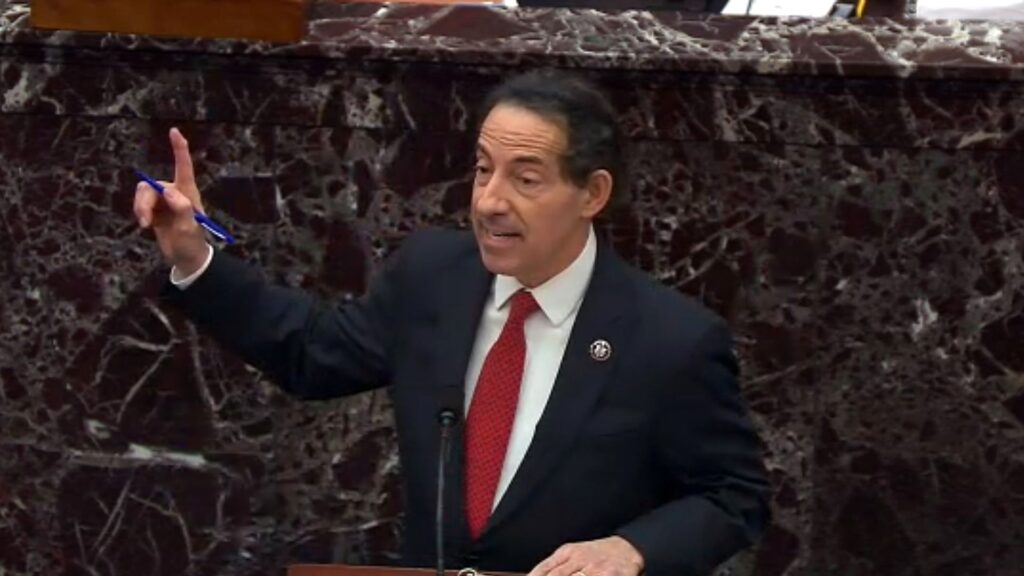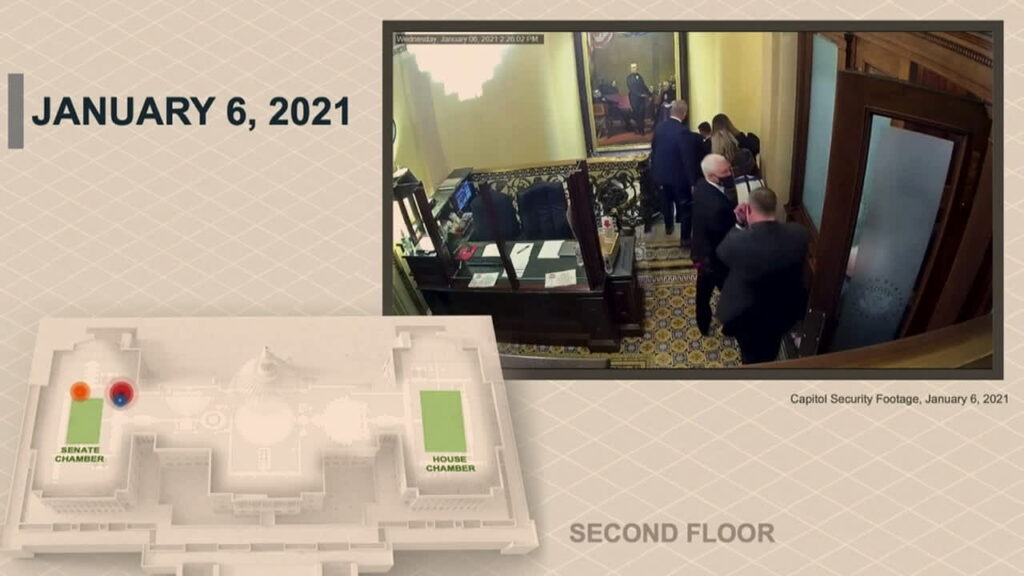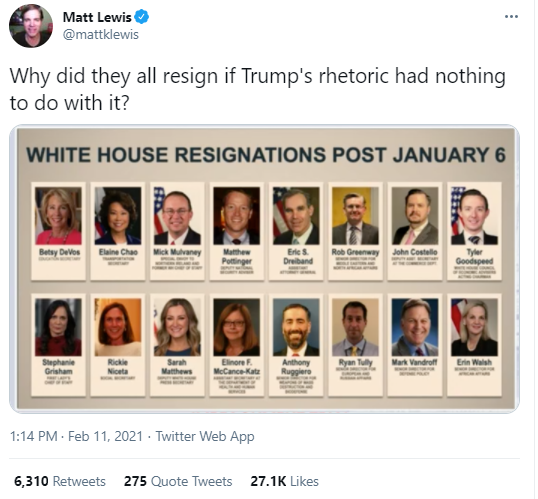It was quite obvious that Trump was grossly guilty of incitement of violent insurrection before this Senate trial, but the Democrats’ impeachment managers have done an amazing job of showing how Trump’s culpability, responsibility, and level of involvement in what happened on January 6 are dramatically worse than it previously seemed.
By Brian E. Frydenborg (LinkedIn, Twitter @bfry1981, YouTube, Facebook) February 13, 2021

SILVER SPRING—After the last three days of Trump’s Senate impeachment trial (the first full day had, absurdly, dealt mainly with the constitutionality of the trial itself apart from a powerful opening argument), in some ways the takeaways are surprisingly profound.
In my time as a journalist, I have passionately advocated the importance of analytical journalism: telling a story to readers not by necessarily adding, highlighting, or focusing primarily on new information, but by putting together and explaining all the component parts of complex and/or massive stories, tying together the information from many articles over a period of time and presenting their sum total in a single piece or a few. Such articles tend to be quite long, which is a major strike in journalism. Another strike is that such work, wherever it will be published, will have to synthesize many articles from many sources other than the publishing outlet, and outlets tend to be rather tribal in not wanting to highlight the work of other outlets so heavily. And a third strike is that, in general but especially in the ultracompetitive and struggling crisis era of current journalism, the emphasis is, by far, to be the first to present something new rather than to pause and take stock of the current body of information (why is it “either/or,” why can there not be plenty of room for both?). These three strikes combine to make such deep-dive analytical pieces quite rare, and I have certainly encountered a lot of opposition (sometimes even hostility) from editors and journalists both to anything that does not offer up some juicy new nugget of information and to analytical journalism in general.
As I have noted before, such a rejectionist approach to analytical journalism is deeply myopic while also contributing to the degree to which the public is confused and unable to weight the importance of so many catchy, endless headlines, and there has been no better example in recent years than the Trump-Russia saga, which I have also taken pains to note (and which is the subject of some of my best deep-dive analytical work).
For many of the journalistic powers that be, “original” reporting is only reporting that contain new scoops, not original analysis no matter how significant that analysis is. In fact, presenting old facts in a new light, new context, and juxtaposed can sometimes be the among the most valuable information and analysis, just as any intelligence agency staff or criminal investigator would tell you. They would note that, especially when it comes to reading intent—which is often the most elusive information and yet is always among the valuable—it is this type of analysis that is often the most useful: figuring how and why each piece fits together is itself revelatory, and intent is best able to be discerned by putting everything together.
And that is what I feel happened during the Democratic impeachment managers’ presentation of the case against Trump, perhaps the single most important example of this type of big-picture analysis on a main stage in America in years.
I also feel somewhat traumatized by the experience of both reliving the Capitol assault and seeing how the whole picture of it comes together. It is a bit like being in a battle and remembering your own experience while also being given the full battle report for how your experiences and impressions fit into the wider truth for the first time; many on social media echoed this sentiment, and most of us can only imagine how much worse this is for any of the people traumatized by actually being in or near the Capitol on January 6.
The day of the Capitol insurrection was obviously traumatizing and terrible enough for most of the wider public watching it on TV and following it on social media, but most of the worst footage and facts would not come out until days, even weeks later (and I am not even getting to the new footage from the Democrats’ impeachment managers). I did not expected anything to seriously alter my views from this trial that I already have regarded as an open-and-shut case, but the Democrats’ presentation on February 10-11 did just that and did so in ways that shocked me.
In seeing so much context added and all the clips I had seen earlier and then some put together to show when and where the insurrectionists were on the Capitol grounds in relation to members of Congress and Vice President Pence, and showing what Trump said and tweeted and when before and during the insurrection, a far more sinister picture has emerged.

And very much as a result of the Democratic impeachment managers’ presentations, it is now clear that Trump acted throughout the day not only to knowingly foment and incite a mob-driven intimidation campaign with more than a few hints of violence against Congress and his vice president at the hour they were tallying the Electoral College votes, but that he reacted to the violence at the Capitol by supporting, leveraging, and excusing it in a way that he fully integrated the insurrectionists and their actions into his long campaign to overturn the election results, overthrow our government and republic.
Indeed, they embraced Trump and he embraced them throughout. Many members of his mob cited Trump’s calls that they march on the Capitol as they were storming it and while arguing and fighting with Capitol police, and while running amok on the Capitol grounds they closely followed and even read allowed his tweets issued while he was watching them storm the Capitol, tweets that encouraged and energized them.
Trump willfully misrepresented the mob, said it was “full of patriots” and that it was “peaceful” even when it was obviously not and he had known his own vice president had to be evacuated within the Capitol because his life was in danger.
During all this, besides following the attack on television, Trump’s main concerns were to reiterate the Big Lie that the election was stolen from him, to criticize Pence for not trying to overturn the election results, and to try to call one Republican Senator, Tommy Tuberville—hiding in the Capitol from the Trumpian mob—and use the situation to pressure the senator to carry out Trump’s plan to overturn the election results.
Hours into the attack on the Capitol, Congress, and Pence, Trump was still expressing support for the insurrection, and when he finally did call his people off—nearly three-and-a-half hours after the insurrection began, plenty of time for his intended targets to be hurt or even killed when he refused requests to call them off or send in reinforcements, even from members of his own staff and Cabinet (a significant number of whom resigned expressly because of Trump’s role in fomenting the insurrection), even from the Republican House Minority Leader Kevin McCarthy—he still, in the very same message, justified their actions and reiterated his Big Lie.

At no time that day did he condemn the insurrection or its attack. This is a man who often tweets back at TV news personalities within minutes of them criticizing him. Trump was never shy or dilatory about condemning violence (real or falsely claimed) perceived (accurately or inaccurately) to come from members of the left. Yet when he was within walking distance from an insurrection at the Capitol carried out by his supporters whom he had just addressed in person, there was no effort to condemn their violence.
Both in their own social media posts and, for those now arrested, in the government’s charging documents, it is clear that these insurrectionists were there because Trump called for them to be there, were acting directly in response to his exhortations, and believed their insurrection was exactly what Trump wanted of them, that they were carrying it out because of and for him at his instruction.
And in all of this, both his “actions and inactions,” to quote Democratic Impeachment Manager Jamie Raskin, speak loudly. From his rallies to his supporters’ storming of the Michigan State Capitol and, separately, attempting to kidnap and possibly execute Michigan’s governor to the near-running off of a highway of a Biden campaign bus by a Trump pickup truck caravan, Trump has repeatedly not only failed to condemn violence and physical intimidation on the part of his acolytes, he has repeatedly praised them for such acts, which literally led into and fed each other. Even in the run-up to the rally, it seems Trump was involved in changing both the date of the rally to coincide with the Electoral College counting at the Capitol and to allow the option for attendees to access the Capitol grounds. The rally itself, date, time, location, themes, and, apparently, freedom to approach the Capitol were all dependent upon or tied intimately to Trump himself.
This is not just lighting a match and walking away. It is jumping into an explosives warehouse while using a flamethrower.
To understand this, a few clips are not enough: you need to watch the whole presentation, especially on that of February 10 (part 1, part 2, part 3, and part 4) but also February 11 (part 1 and part 2).
Before I saw nearly all of this in its entirety, I had still thought it was quite clear that Trump had intended the protest to go to the Capitol, had sought to stir up the crowd and cause them to disrupt the proceedings there, and felt that he more or less just embraced somewhat passively what unfolded after that. This, of course, for a sitting president is enough for him to be grossly guilty of incitement both from a political impeachment perspective and a legal criminal perspective (two different things, in spite of Trump’s defense attorneys’ attempts to muddy the waters). But after I saw the Democratic impeachment managers’ presentation, it became clear to me that Trump was no passive observer of what transpired once his crowd left his rally, that Trump deliberately timed his talk to begin just before and last through the beginning of the constitutional proceedings at the Capitol, and that he actively followed and used the insurrection to further his plot to overthrow our republic’s constitutional order and peaceful transition of power, which we had in this country at the presidential from 1789-2017 until Trump’s insurrection, 2021 being the first non-peaceful transfer of presidential power in 232 years.
Even as a passive careless fool, he would be intensely culpable for the insurrection carrying the weight of his office as president, but, as was the case with the circumstances leading to his first impeachment, he knew what he was doing and it was an active campaign in which he was calling the shots and deeply involved to maintain power through nearly any means necessary, no matter how illegal or wrong. And demonstrating this to be the case with the Capitol insurrection, the case made by the Democratic impeachment managers in Trump’s Senate trial is devastating for Trump and anyone who would defend his actions or claim he does not bear extreme and primary responsibility for the appalling events of January 6, 2021.
Correction appended and updated April 10, 2021 to correct the timeline of events and to add sources related to that timeline.
Also see Brian’s related Jerusalem Report article, Trump Capitol insurrection: The history behind the violence, his related article here, Trump’s Impeachment Trial Exceedingly Simple: No Excuse Not to Convict, his related interview on The Jist Chatter Podcast, and his eBook, A Song of Gas and Politics: How Ukraine Is at the Center of Trump-Russia, or, Ukrainegate: A “New” Phase in the Trump-Russia Saga Made from Recycled Materials, available for Amazon Kindle and Barnes & Noble Nook (preview here), and be sure to check out my podcast interview with Georgia election officials Brad Raffensperger and Gabriel Sterling, both cited in Trump’s second Senate trial!

© 2021 Brian E. Frydenborg all rights reserved, permission required for republication, attributed quotations welcome
If you appreciate Brian’s unique content, you can support him and his work by donating here
Feel free to share and repost this article on LinkedIn, Facebook, and Twitter. If you think your site or another would be a good place for this or would like to have Brian generate content for you, your site, or your organization, please do not hesitate to reach out to him!